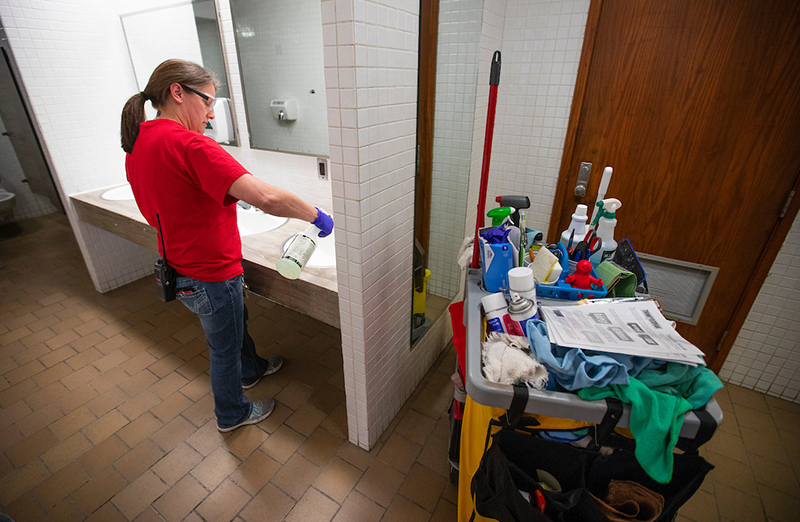An employee survey helped Iowa State leaders identify ways to better support faculty and staff during the coronavirus crisis, including outreach about wellness resources, information technology support, employee and supervisor expectations, and long-term planning.
Based on responses to the survey conducted the week after spring break, employees generally have positive outlooks. Most Iowa State employees think their supervisor is supportive, feel safe if they're working on campus, have clear expectations and sufficient resources if they're working remotely, and are confident in university leadership.
“The engagement between supervisors and employees is always important, but especially so during this unprecedented situation. Whether working remotely or working safely on campus, we all have new challenges to navigate that can impact our productivity. We appreciate the extra effort made by supervisors to reach out and provide guidance and grace as employees adapt to new working environments,” said Kristi Darr, interim vice president for university human resources.
The survey showed what resources and information faculty and staff were seeking. Many initiatives and communications were developed to help address those concerns, including:
- Several ISU leaders spoke during a virtual panel April 9 to provide resources and thanks to critical employees still working on campus.
- Information for on-campus staff is being posted near time clocks and other high-traffic areas.
- University human resources (UHR) created a COVID-19 webpage with guidance on reduced operations, professional development links, and detailed information on time off and leave options, including the new leave program specifically for absences related to COVID-19.
- In a message to faculty and staff April 20, President Wendy Wintersteen provided an update on the budget impact of the virus.
- Supervisors were encouraged in memos from Wintersteen and UHR to adjust productivity expectations for employees working from home, especially if they're balancing child care or other obligations.
- An FAQ provides guidance on remote work equipment and expenses. In a message to faculty and staff April 8, Wintersteen encouraged employees to retrieve work equipment from their campus office, if needed.
“The survey reinforced how critical communication is during a crisis. The results helped us better understand where we needed to improve our information sharing and what channels are most effective for faculty and staff. We will continue to make communication a top priority in our response efforts,” Wintersteen said.
Wintersteen released a summary of the survey's key findings in an April 20 message to faculty and staff. The anonymous survey was developed by UHR and the institutional research office and conducted March 25-27.
About 54% of the 6,659 employees who received an email with a link to the survey responded, including 62% of professional and scientific staff, 52% of merit staff and 46% of faculty. About 60% of respondents were working remotely, 24% were in their normal workplace and 16% were working remotely when they can but are on campus to perform portions of their job.
How work is going
Two-thirds of employees surveyed strongly agreed their manager was supporting them during the COVID-19 crisis, and more than half strongly agreed they are confident in senior leaders making the right decisions for Iowa State.
Among respondents working remotely, more than half were extremely clear about what was expected from them while working from home, and more than half had all essential resources they needed. More than three-quarters of remote workers were satisfied with their IT support, and two-thirds said their team is good at discussing impacts of the changes and connecting informally.
About one-third of remote workers also were providing child care, and the majority said it impacted their work at least some of the time. Along with internet issues and computer desk setup, the time and space available due to other family being home were the top performance barriers identified by employees working remotely. Among all employees, additional communication about balancing caretaking and job duties was a common request.
Two-thirds of employees working on campus were neutral or agreed that their health and safety were being protected, while one-third were concerned. More than half of respondents working on campus said they had all the information, training and protective equipment they needed to safely do their job in their usual workplace. Their top requests for additional needs included work supplies and resources as well as more information about what services and buildings remain open.
Staying well
More than three-quarters of respondents gauged their own well-being as neutral or better. Successfully transitioning to working from home, feeling safe and healthy, communication with supervisors and colleagues, and job security were listed as reasons for positivity. Employees with negative self-assessments of their well-being cited health concerns, stress, uncertainty, lack of communication, remote working without support, and child care and family issues.
More than half of employees surveyed strongly agreed they have the information they need about wellness benefits, and half strongly agreed university communication about the virus has been helpful.
Surveyed employees volunteered numerous ways they have stayed connected with colleagues, including daily virtual meetings and scheduled team meetups, phone check-ins and text messaging, along with informal methods such as sharing pet photos, holding virtual happy hours and giving baked goods to colleagues.


